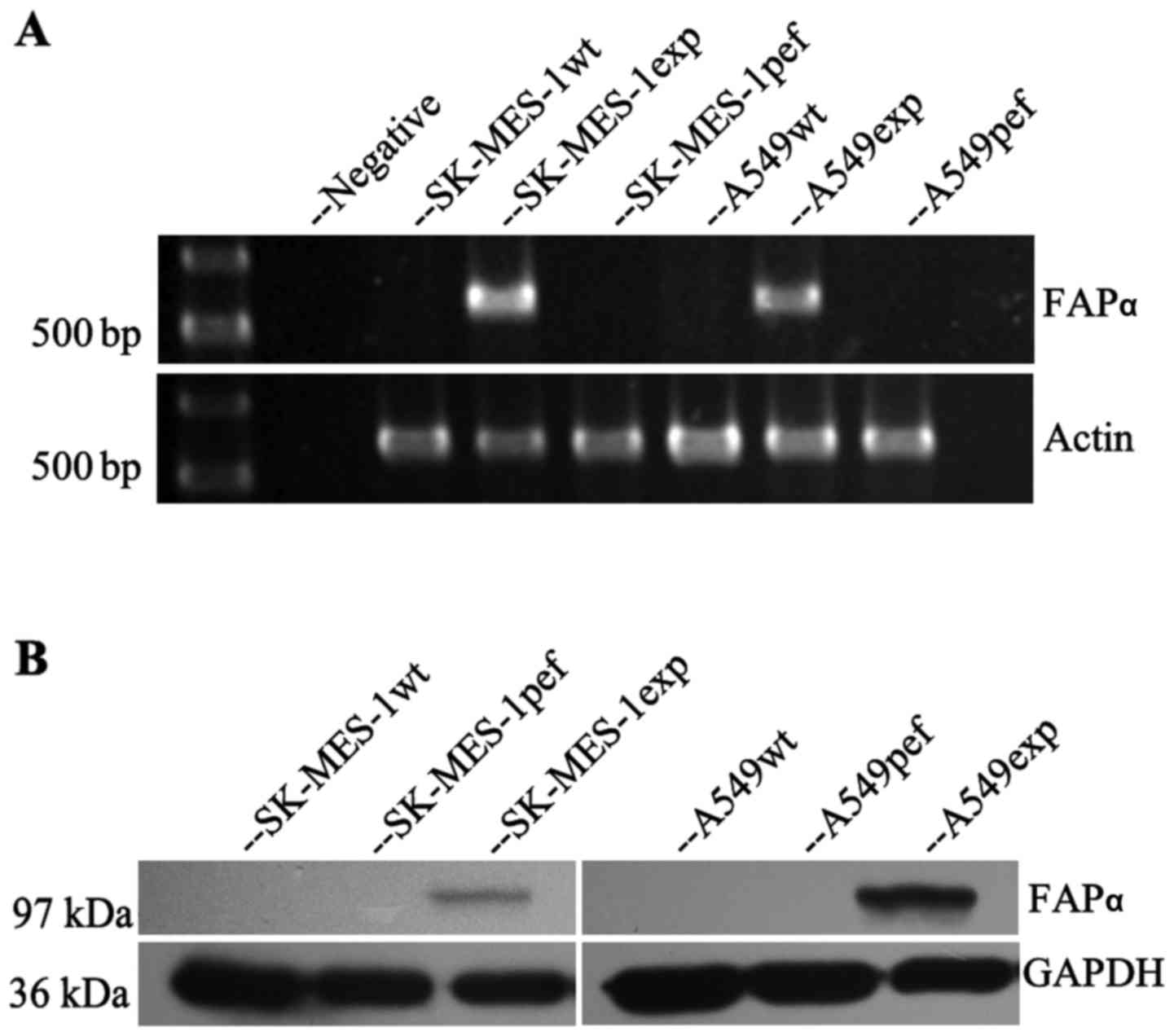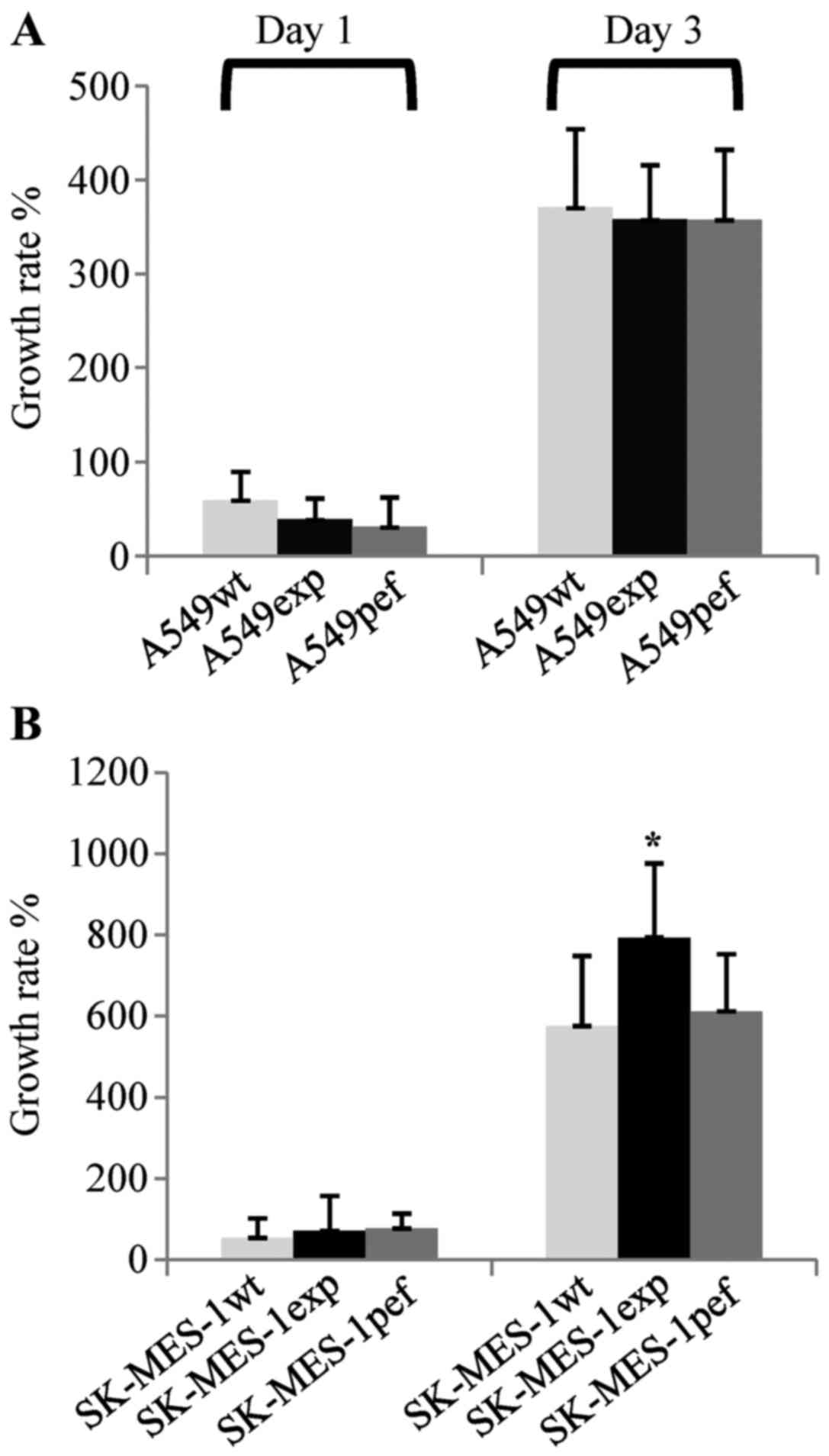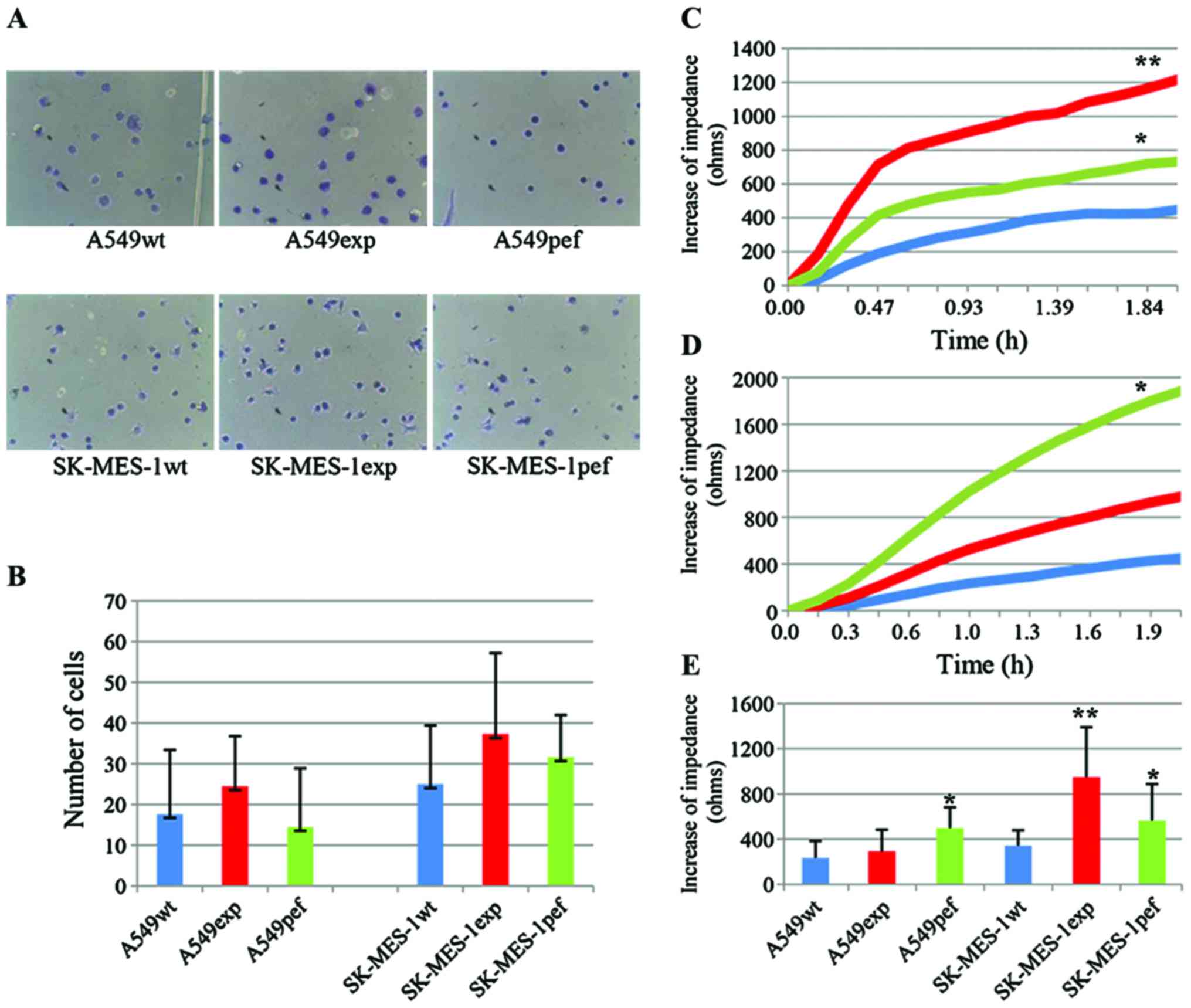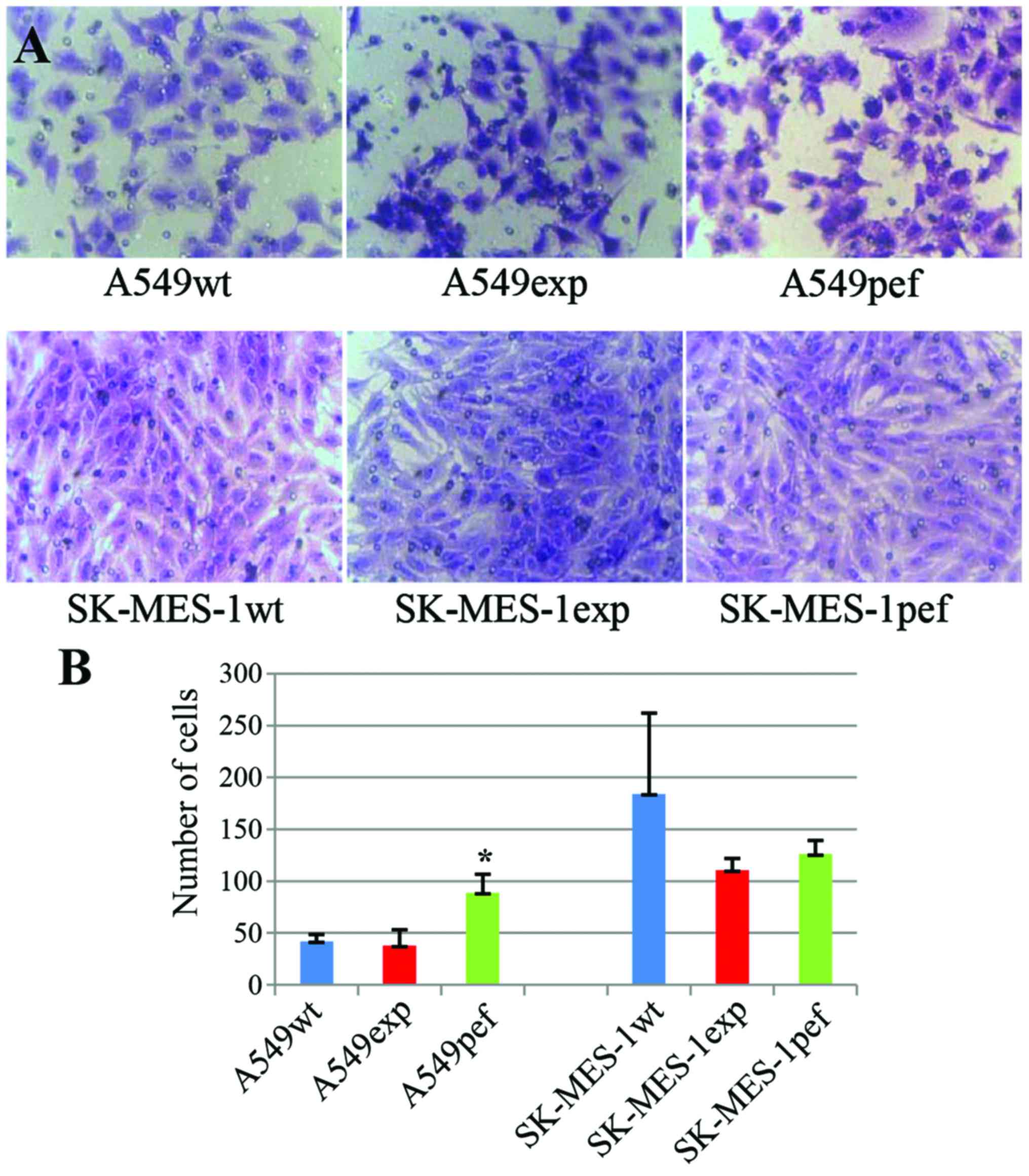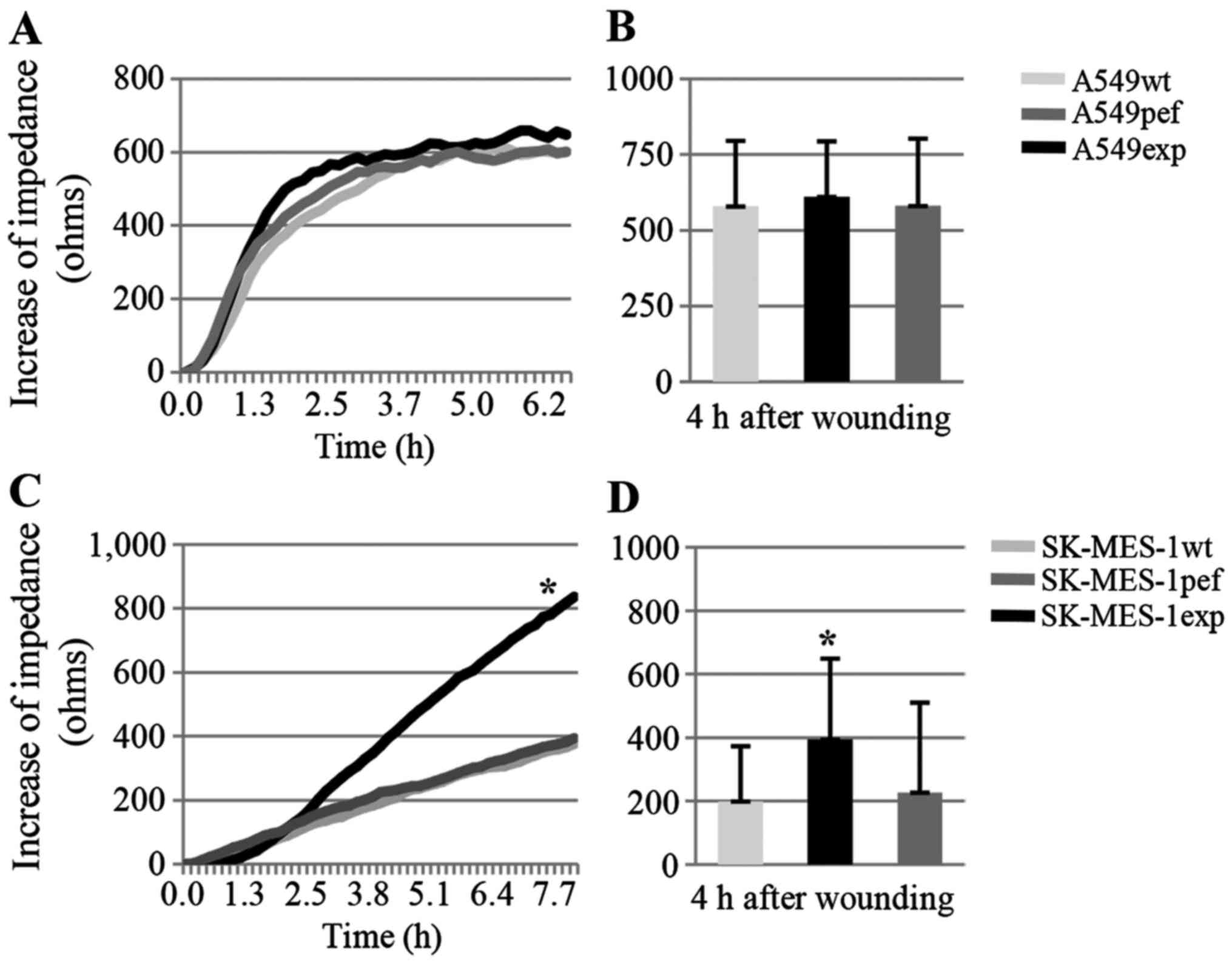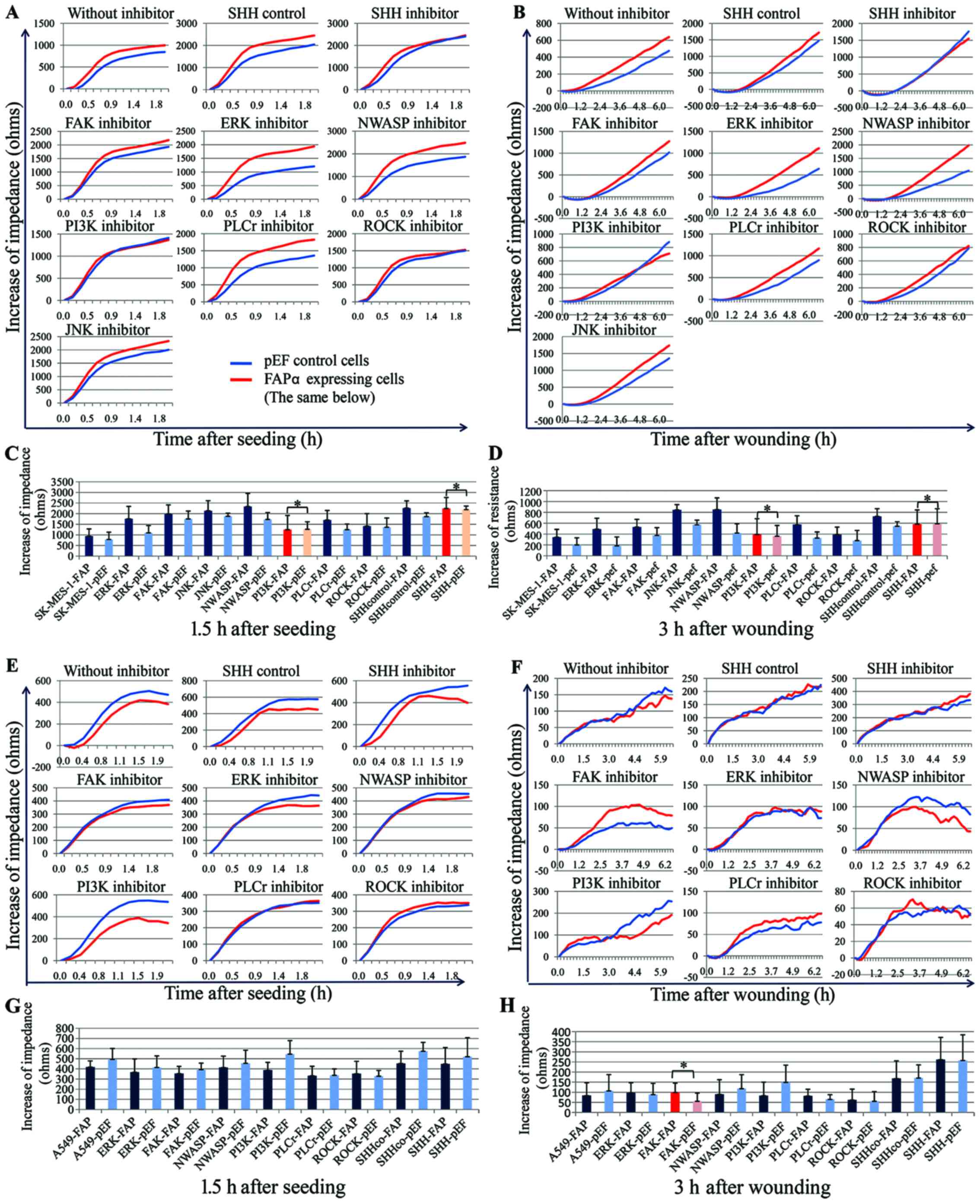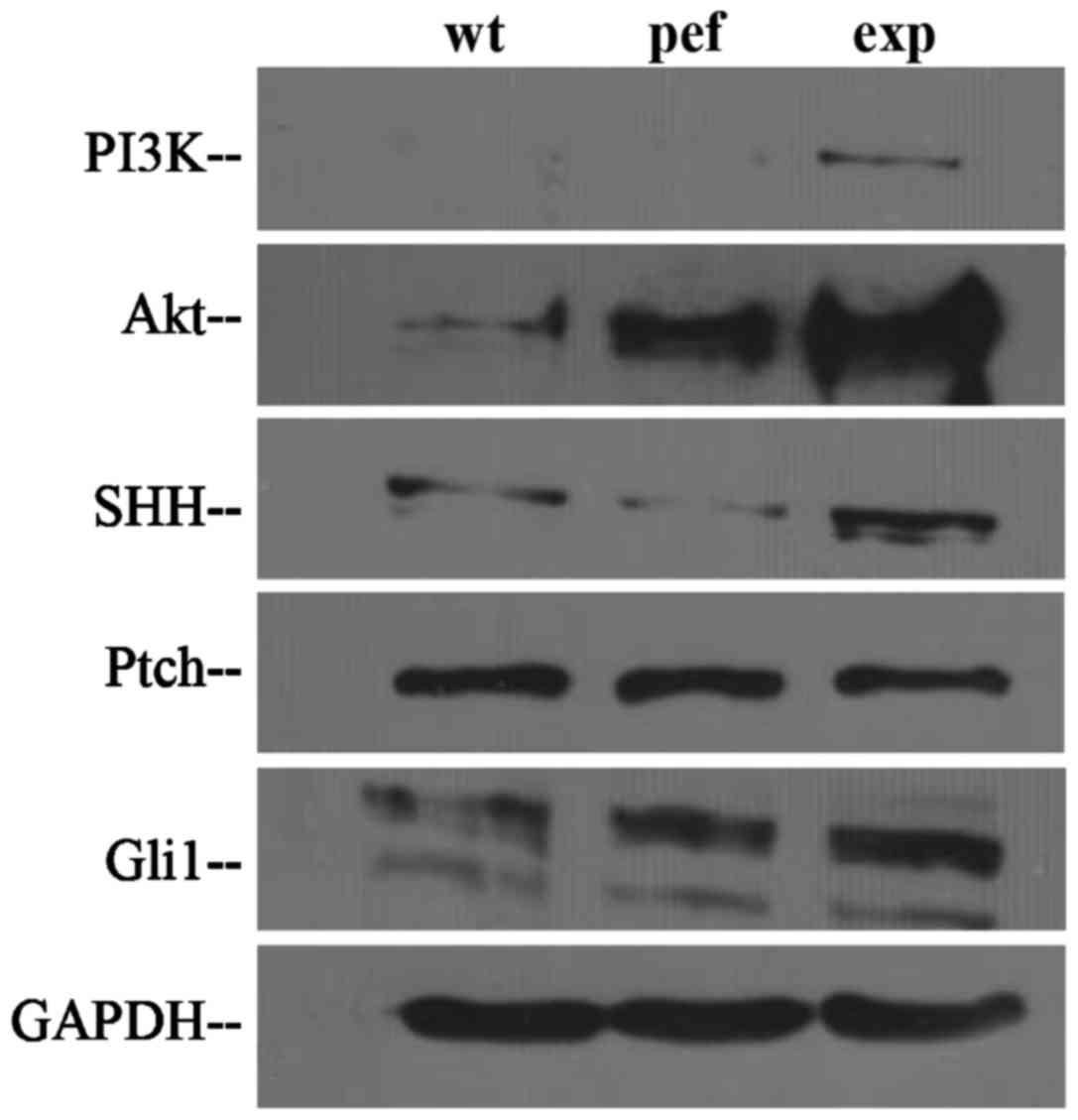Fibroblast activation protein-α promotes the growth and migration of lung cancer cells via the PI3K and sonic hedgehog pathways
- Authors:
- Published online on: October 27, 2017 https://doi.org/10.3892/ijmm.2017.3224
- Pages: 275-283
-
Copyright: © Jia et al. This is an open access article distributed under the terms of Creative Commons Attribution License.
Abstract
Introduction
The epithelial-to-mesenchymal transition (EMT) is a complicated and critical process in the metastatic spread of cancer cells. The transition of morphology of a cancer cell from an epithelial to a mesenchymal morphology leads to increased migratory and invasive cellular properties. Previous studies have demonstrated that EMT in cancer cells involves the upregulation of mesenchymal markers and the downregulation of epithelial cell markers (1,2). For example, fibroblast specific protein-1 (S100A4) is a prototypical fibroblast marker of EMT in cancer; the expression of S100A4 is associated with cellular motility and the regulation of cell polarization through its effects on the localization of protrusions, which involves interactions with myosin-IIA (1,3). The α-smooth muscle actin (αSMA) protein is expressed by vascular smooth muscle and myoepithelial cells, and is also considered a marker of EMT. There is also evidence that type 3 EMT is associated with αSMA in basal-like breast cancer (2,4). Therefore, the function of these molecules expressed by stromal fibroblasts and epithelium-derived cancer cells may be importance in EMT.
Fibroblast activation protein-α (FAPα) is an integral membrane serine peptidase. Previous studies have shown that FAPα is expressed primarily in fetal mesenchymal tissues, stromal fibroblasts, wounded tissues and stromal fibroblasts of malignant epithelial tumors (5–7). FAPα expressed by stromal cancer-associated fibroblasts has dipeptidyl peptidase activity (8,9) and collagenolytic activity (10,11). By degrading the extracellular matrix, FAPα promotes the growth and metastasis of cancer cells (12–14). The overexpression of FAPα is also associated with distant metastasis, tumor recurrence and poor survival rates (15,16). In addition, previous studies have shown that FAPα is expressed in certain types of epithelium-derived cancer, including breast (17), gastric (18), esophageal (19), ovarian (20) and colorectal cancer (21).
The functions of cancer cell-expressed FAPα have been investigated in a number of studies and the results from these suggest that FAPα has a non-enzymatic function. Wang et al analyzed the effect of the overexpression of FAPα on the LX-2 human hepatic stellate cell line (22); it was found that the overexpression of FAPα increased the adhesion, migration and invasion of LX-2 cells, and that the proteolytic activity of FAPα was not necessary for these functions (22). Huang et al used two inhibitors, PT-630 and LAF-237, to inhibit the dipeptidyl peptidase activity of FAPα (23), and found that the inhibitors were unable to slow the growth of tumors in severe combined immunodeficient (SCID) mice implanted with FAPα-expressing breast cancer WTY-1/6 cells (MDA MB-231 cells transfected with FAPα) and MDA-MB-435 cells (endogenously express FAPα). In addition, breast cancer cells expressing a catalytically inactive mutant of FAPα produced tumors, which grew rapidly (23). Wang et al found that the knockdown of FAPα in oral squamous cancer cells suppressed cell proliferation in vitro and inhibited the growth of tumor xenografts in mice in vivo. Notably, suppressing FAPα in oral squamous cancer cells significantly decreased the expression of phosphorylated phosphatidylinositol-3-kinase (PI3K), protein kinase B (AKT), mitogen-activated protein kinase kinase 1/2 and extracellular signal-regulated kinase (ERK)1/2, and upregulated the expression of phosphatase and tensin homolog (PTEN) (24). In our previous study (25), the overexpression of wild-type FAPα and the enzymatic mutant FAPS624A, in which the serine catalytic triad was disrupted, markedly increased cellular growth and motility in MCF-7 breast cancer cells. These observations were consistent with those for FAPα-silenced BT549 breast cancer cells. Western blot analysis also revealed that the overexpression of wild-type FAPα and the enzymatic mutant FAPS624A resulted in the activation of PI3K/AKT and matrix metalloproteinase 2/9 (MMP2/9) (25). These results suggested that FAPα may serve as an oncogene and be involved in the regulation of cell signaling pathways.
Therefore, the present study analyzed the function of FAPα in lung cancer cells in order to examine its non-enzymatic function. It was hypothesized that, as a membrane protein, FAPα may be involved in the regulation of certain signaling pathways and, through this mechanism, exert its effect on lung cancer cells.
Materials and methods
Materials and cell lines
The SK-MES-1 squamous cell carcinoma (SCC) and A549 adenocarcinoma (AC) human lung cancer cell lines were obtained from the American Type Culture Collection (Manassas, VA, USA). Primary antibodies against human FAPα (cat. no. AF3715) were from R&D Systems, Inc. (Minneapolis, MN, USA). Primary antibodies against glyceraldehyde 3-phosphate dehydrogenase (GAPDH; cat. no. sc-32233) and an inhibitor (Y-27632; cat. no. sc-3536) of Rho-associated protein kinase (ROCK) were from Santa Cruz Biotechnology, Inc. (Santa Cruz, CA, USA). The focal adhesion kinase (FAK) inhibitor (cat. no. 3414) was from Tocris Bioscience (Bristol, UK). The ERK1/2 inhibitor (FR180204, cat. no. 328007), phospholipase C-γ (PLCγ) inhibitor (U73122, cat. no. 662035), neural Wiskott-Aldrich syndrome protein (NWASP) inhibitor (wiskostatin, cat. no. 681525), PI3K inhibitor (wortmannin, cat. no. 681675), c-Jun N-terminal kinase (JNK) inhibitor (SP600125, cat. no. 420119), sonic hedgehog (SHH) inhibitor (cyclopamine, cat. no. 239803) and a negative control of cyclopamine (tomatidine, cat. no. 614350) were from Calbiochem; Merck Millipore (Darmstadt, Germany). Matrigel (reconstituted basement membrane) was purchased from Collaborative Biomedical Products, Inc. (Bedford, MA, USA). Transwell plates equipped with a porous insert (8-μm pore size) were from BD Biosciences (Franklin Lakes, NJ, USA). Reverse transcription-polymerase chain reaction (RT-PCR) reagents and plasmid extraction kits were from Sigma-Aldrich, Inc. (St. Louis, MO, USA). Antibodies against human PI3K (cat. no. ab22653), AKT (cat. no. ab8805), SHH (cat. no. ab53281), Patched (Ptch; cat. no. ab53715), and GLI family zinc finger 1 (Gli1; cat. no. ab151796) were from Abcam PLC (Cambridge, UK).
Construction of FAPα-expressing lung cancer cell lines
The cDNA of FAPα (NM_004460) was inserted into a pEF6/V5-His vector (Invitrogen; Thermo Fisher Scientific, Inc., Waltham, MA, USA) and maintained at −80°C in the Laboratory of Carcinogenesis and Translational Research, Peking University Cancer Hospital and Institute, as described in our previous study (25). The SK-MES-1 and A549 lung cancer cells were cultured in DMEM/F12 media at 37°C with 5% CO2. The cells were transfected with the pEF6/V5-FAPα plasmid by electroporation. Following the selection of transfected cells with blasticidin S (5 μg/ml) and verification via RT-PCR analysis (RT-reaction: annealing at 65°C for 5 min, extension at 55°C for 20 min, inactivation at 75°C for 15 min. PCR reaction: initial denaturation at 94°C for 5 min; then denaturation at 94°C for 30 sec, annealing at 55°C for 30 sec, extension at 72°C for 1 min in each cycle for totally 25 cycles, followed by a final extension of 10 min at 72°C), the following stably transfected cells were established: FAPα-overexpressing cells (SK-MES-1exp and A549exp), plasmid vector-transfected control cells (SK-MES-1pef and A549pef), and wild-type cells (SK-MES-1wt and A549wt). The transfected cells were continually cultured in a maintenance medium, which contained 0.5 μg/ml blasticidin S.
In vitro growth, adhesion and invasion assays
For the growth assay, the cells were plated into a 96-well plate at a density of 2,000 cells/well (n=12) followed by a period of incubation. The cells were either fixed in 10% formaldehyde on the day of plating or 3 days later. Crystal violet (0.5% w/v) was used to stain the cells. Subsequently, the crystal violet was dissolved with 10% (v/v) acetic acid and the absorbance of cells, which represented the cell number, was determined at a wavelength of 540 nm.
For the adhesion assay, a 96-well plate was pre-coated with 5 μg of Matrigel and left to dry overnight. Following rehydration with serum-free media, 1,500 cells were seeded into each well (n=6). Following incubation for 60 min, the non-adherent cells were washed off using BSS buffer. The remaining cells were fixed with 4% formalin and stained with 0.5% crystal violet. The numbers of adherent cells were then counted under an Olympus CX31 microscope.
For the invasion assay, Transwell inserts with a 8-μm pore size were coated with 50 μg of Matrigel and air-dried. Following rehydration with serum-free media, the cells were seeded at a density of 30,000 cells/insert (n=5). After 3 days of incubation at 37°C with 5% CO2, the cells, which had migrated through the matrix and adhered to the other side of the insert were fixed in 4% formalin, stained with 0.5% (w/v) crystal violet, and counted under a microscope.
Electric cell-substrate impedance sensing (ECIS)-based cell attachment and migration assay
An ECIS instrument (Applied BioPhysics, Inc., Troy, NY, USA) was used to record the adhesive and migratory abilities of the cells, which were determined from the changes in the impedance of cells. 96W1E arrays were incubated with complete medium for 1 h, following which 50,000 lung cancer cells were seeded into each well (n=16). Electrical changes were continuously monitored for up to 24 h, with electrical wounding performed at 6 h. Multiple frequencies (1,000, 2,000, 4,000 and 8,000 Hz) were used to assess the nature of changes in resistance.
Inhibition of signaling pathways with inhibitors
In order to examine the potential crosstalk between FAPα and adhesion and migration-associated signaling pathways, inhibitors of FAK, ERK1/2, ROCK, PLCγ, JNK, NWASP, PI3K and SHH were used in an ECIS-based cell function assay. A total of 50,000 cells were suspended in 200 μl DMEM with inhibitors of FAK, ERK1/2, ROCK, PLCγ, NWASP, JNK, PI3K and SHH, respectively, to a final concentration of 100 nM. Changes in electrical resistance under multiple frequencies (1,000, 2,000, 4,000 and 8,000 Hz) were continuously monitored for up to 24 h, with electrical wounding performed at 6 h in the ECIS-based wounding assay (n=8).
Western blot analysis
Western blot analysis was performed to detect the expression of FAPα and other downstream signaling pathway molecules in the transfected SK-MES-1 lung cancer cells and control cells. The confluent cells were pelleted and then lysed in lysis buffer containing 2.4 mg/ml Tris, 4.4 mg/ml NaCl, 5 mg/ml sodium deoxycholate, 20 μg/ml sodium azide, 1.5% Triton X-100, 100 μg/ml phenylmethylsulfonyl fluoride, 1 μg/ml leupeptin and 1 μg/ml aprotinin, for 45 min at 4°C. Following lysis and centrifugation at 10,000 × g for 15 min at 4°C, the isolated proteins were diluted in sample buffer and the concentration of each sample was measured using an improved Lowry assay (DC protein assay kit; Bio-Rad Laboratories, Inc., Hercules, CA, USA). The samples were adjusted to equal concentrations (2 mg/ml) with sample buffer and then boiled at 100°C for 5 min prior to separation on a 10% polyacrylamide gel. Following electrophoresis, the separated protein samples were transferred onto polyvinylidenedifluoride membranes (EMD Millipore, Billerica, MA, USA) and incubated at 4°C overnight with primary antibodies against FAPα, PI3K, AKT, SHH, Ptch, Gli1 and GAPDH at a dilution of 1:200. The membranes were then incubated with specific peroxidase-conjugated secondary antibodies (cat. nos. sc-2357 or sc-2031; Santa Cruz Biotechnology, Inc.) at a dilution of 1:1,000 for 40 min at room temperature. The protein signals were detected using an enhanced chemiluminescence system (Pierce; Thermo Fisher Scientific, Inc.).
Statistical analysis
All results are expressed as the mean ± standard error of the mean. One-way analysis of variance and an independent samples t-test were used to evaluate the differences between groups in all the assays performed, with the resultant P-values representing two-sided tests of statistical significance. All statistical analyses were performed using SPSS 17.0 software (SPSS, Inc., Chicago, IL, USA). P<0.05 was considered to indicate a statistically significant difference.
Results
Expression of FAPα in lung cancer cells
To identify the oncogenic function of FAPα in lung cancer cells, FAPα was transfected into the FAPα-null SK-MES-1 and A549 lung cancer cell lines. RT-PCR and western blot analyses were used to confirm the expression of FAPα in the transfected cells. The overexpression of FAPα in the SK-MES-1 and A549 cells was successfully established (Fig. 1).
Overexpression of FAPα promotes the growth of SK-MES-1 cells
The present study first examined the effect of the overexpression of FAPα on cellular growth in vitro. Compared with the SK-MES-1wt cells, the overexpression of FAPα significantly increased the growth rate of the SK-MES-1exp cells at 3 days post-seeding (n=12; 575.5±171.9 vs. 793.6±140.1%, respectively; P=0.003), which was also significantly higher, compared with that of the SK-MES-1pef cells (611.6±181.8; P=0.012). By contrast, the growth rate of the A549exp cells (357.5±74.2%) was similar to the growth rates of the A549wt cells (370.6±83.2; n=12; P=0.686) and A549pef cells (357.8±57.4%, P=0.989) at 3 days post-seeding (Fig. 2).
Overexpression of FAPα increases the attachment of SK-MES-1 cells to basement membrane proteins
In a matrix gel-based adhesion assay, compared with the control cells, FAPα-expressing SK-MES-1exp and A549exp cells showed increased adhesion to the matrix gel 1 h following seeding; however, no statistically significant differences were found between the groups of SK-MES cells (n=6; SK-MES-1wt vs. SK-MES-1exp, 25±14.4 vs. 37.3±19.9; P=0.246; SK-MES-1pef vs. SK-MES-1exp, 31.7±10.3 vs. 37.3±19.9; P=0.549) or A549 cells (A549wt vs. A549exp, 17.7±15.7 vs. 24.5±12.3; P=0.422; A549pef vs. A549exp, 14.5±14.4 vs. 24.5±12.3, P=0.225) (Fig. 3A and B). To confirm the results of the matrix gel-based adhesion assay, an ECIS-based cell function assay was performed as a more sensitive and accurate assessment. In the first phase post-cell seeding, increased impedance reflects the ability of cells to adhere to the substrate; the faster the impedance increases, the higher the rate of cell attachment to the substrate. In the present study, compared with the SK-MES-1wt and SK-MES-1pef control cells, the FAPα-expressing SK-MES-1exp cells showed increased attachment at 1 h post-seeding (n=12; SK-MES-1wt vs. SK-MES-1exp, 343.1±135.3 vs. 948.3±442.7 ohms; P=0.001; SK-MES-1pef vs. SK-MES-1exp, 566.3±321.0 vs. 948.3±442.7 ohms; P=0.037). However, in the A549 cells, the vector-transfected A549pef cells showed the highest attachment ability, whereas the A549exp cells and A549wt cells exhibited similar attachment abilities (n=12; A549wt vs. A549exp, 234.1±149.4 vs. 292.2±191.0 ohms; P=0.416; A549pef vs. A549exp, 497.7±184.5 vs. 292.2±191.0 ohms; P=0.014) (Fig. 3C–E).
Overexpression of FAPα does not promote the invasion of lung cancer cells
To analyze the effect of the overexpression of FAPα on the invasion of lung cancer cells, the present study performed an in vitro matrix gel-based invasion assay. Although FAPα has dipeptidyl peptidase and collagenolytic activities, the results showed that the overexpression of FAPα did not increase the invasive ability of either SK-MES-1 or A549 cells. By contrast, the number of invaded cells in the FAPα-expressing SK-MES-1 cell group on day 3 was lower, compared with that in the wild-type and vector-transfected control cell groups; however, no significant differences were observed between the groups (n=5; SK-MES-1wt vs. SK-MES-1exp, 184.2±77.8 vs. 110.4±11.4; P=0.138; SK-MES-1pef vs. SK-MES-1exp, 126.0±13.2 vs. 110.4±11.4; P=0.081). In the A549 cells, the number of invaded cells in the FAPα-expressing A549exp cell group on day 3 was similar to that in the A549wt cell group (n=5; 37.8±15.4 vs. 42.0±6.5, respectively; P=0.59), but less than that in the A549pef group (88.8±17.9 vs. 37.8±15.4; P=0.001) (Fig. 4).
Overexpression of FAPα increases the migration of SK-MES-1 cells
To investigate the effect of FAPα on the migration of lung cancer cells, the more accurate ECIS-based wounding assay was used rather than a physical scratch-wound assay. In the ECIS method, the wound is created in the confluent cell monolayer using a high voltage shock, and the faster the increase in impedance following wounding, the higher the rate of cellular migration into the wound. As an additional measure of accuracy, the change of impedance is recorded automatically rather than using a manual measurement. In the present study, the overexpression of FAPα significantly elevated the migration ability of SK-MES-1 cells 4 h post-wounding (n=16; SK-MES-1wt vs. SK-MES-1exp, 200.0±173.2 vs. 394.8±254.5 ohms; P=0.001; SK-MES-1pef vs. SK-MES-1exp, 228.0±282.6 vs. 394.8±254.5 ohms; P=0.017). However, the overexpression of FAPα in A549 cells had no effect on cell migration rate when compared with control cells 4 h post-wounding (n=16; A549wt vs. A549exp: 578.8±215.7 vs. 610.2±182.7 ohms; P=0.66; A549pef vs. A549exp, 580.2±221.8 vs. 610.2±182.7 ohms; P=0.68) (Fig. 5).
Inhibitors of SHH and PI3K inhibit the increases in cell attachment and migration induced by the overexpression of FAPα
To examine the potential interaction of FAPα with signaling pathways potentially responsible for the increased adhesive and migratory properties of SK-MES-1 lung cancer cells, a panel of small-molecule inhibitors of a number of signaling pathways were screened, including ROCK, FAK, NWASP, ERK1/2, PLCγ, JNK, PI3K and SHH. Using an ECIS assay (n=8 for each experiment), the effects of these inhibitors on cell attachment and migration were assessed. Compared with the SK-MES-1pef cells, only the inhibitors of SHH and PI3K significantly inhibited the increased the cell attachment and motility (Fig. 6A–D) of the FAPα-expressing SK-MES-1exp cells.
In the earlier cell function assay, the overexpression of FAPα in A549 cells failed to increase cellular adhesion and migration. The present study subsequently analyzed the effects of the above inhibitors on the attachment and motility of A549 cells. The results showed that there was minimal difference in the attachment rate of the A549exp cells following treatment with the inhibitors; only the inhibitor of FAK stimulated the migration of A549exp cells, with the other inhibitors having no marked effect on cell migration (Fig. 6E–H).
FAPα regulates cellular functions through the PI3K/AKT and SHH/Gli1 pathways
To determine whether the effects of FAPα on the cellular functions of SK-MES-1 cells were associated with the PI3K/AKT and SHH pathways, western blot analysis was performed to detect the protein expression levels of total PI3K, AKT, SHH, Ptch and Gli1. As shown in Fig. 7, compared with the control cells, the protein levels of AKT and PI3K were markedly increased in the SK-MES-1exp cells. The protein levels of SHH and Gli1 were also increased in the SK-MES-1exp cells. By contrast, the levels of Ptch were similar in the SK-MES-1exp and control cells.
Discussion
FAPα is an integral membrane serine peptidase. Preliminary studies have shown that FAPα is expressed primarily in fetal mesenchymal tissues, stromal fibroblasts, wounded tissues, and stromal fibroblasts of malignant epithelial tumors (5–7). There is increasing evidence that the expression of FAPα is not confined to stromal fibroblasts but is also present in various types of epithelium-derived cancer cells (17–20). Therefore, the role of FAPα in cancer cells may differ from that in fibroblasts. Goodman et al found that the suppression of FAPα in MDA-MB-435 and MDA-MB-436 human breast cancer cell lines, which normally express FAPα, rendered these cells sensitive to serum starvation (26). Cheng et al reported that mice inoculated with FAPα-transfected HEK293 cells were two to four times more likely to develop tumors, compared with those inoculated with FAPα-null control cells (27). Additionally, in an in vivo mouse model, FAPα-expressing MDA-MB-231 breast cancer cells grew more rapidly than control cells (28). Previous studies have confirmed these early findings and suggested that FAPα expressed by cancer cells may serve as an oncogene. For example, it was found that FAPα promoted ovarian cancer cell proliferation, drug resistance, invasiveness and migration in vitro, and that the silencing of FAPα in SKOV3 cells significantly reduced tumor growth in a xenograft mouse model (29). Our previous study (25) showed that the overexpression of FAPα markedly increased the growth, adhesion, invasion and migration abilities of MCF-7 breast cancer cells, whereas the knockdown of FAPα in BT549 breast cancer cells decreased these abilities. In the present study, the overexpression of FAPα markedly increased the growth, adhesion and migration of SK-MES-1 lung cancer cells. Therefore, these results suggested that the FAPα expressed by epithelial cancer cells had an oncogenic function. However, the overexpression of FAPα failed to promote the growth and motility of A549 cells in the present study. One reason for this may be the difference in cell type between SK-MES-1 (SCC) and A549 (AC) cells. However, Du et al reported that FAPα was expressed in AC specimens from patients with lung cancer (30). Therefore, the role of FAPα in lung AC cells requires clarification in further investigations.
The detailed mechanisms by which FAPα in epithelial cancer cells promote cell growth and motility remains to be fully elucidated. However, studies have revealed that FAPα has important non-enzymatic functions, which enable it to regulate the proliferation and spread of cancer cells (22,23,25). Huang et al found that inhibitors of FAPα did not decrease the growth of FAPα-expressing breast cancer cells, and that breast cancer cells expressing a catalytically inactive mutant of FAPα produced tumors rapidly in a SCID mouse model (23). Our previous study also showed that an enzymatic mutant of FAP, in which the serine catalytic triad was disrupted, markedly increased cellular growth and motility in MCF-7 breast cancer cells (25). Taken together with previous results, it appears that the tumorigenicity of FAPα expressed by cancer cells is not dependent on its enzymatic activity. There is also increasing evidence that FAPα is involved in the regulation of signaling pathways. In oral SCC cells, it has been reported that the knockdown of FAPα inactivated the PTEN/PI3K/AKT and Ras-ERK signaling pathways, resulting in the suppression of oral SCC cell proliferation, migration and invasion (24). In ovarian cancer cells, FAPα in combination with integrin α3β1 and the uPAR signaling complex mediate cellular migration via the small GTPase Rac1 pathway (31). Our previous study showed that the FAPα-mediated promotion of cell growth and motility in breast cancer cells was accompanied by the upregulation of MMP2/9, phosphorylated-PI3K and phosphorylated-AKT (25). In addition, FAPα expressed by stromal cells has been reported to be involved in the regulation of signaling pathways, including RhoA (32), β-catenin (33) and fibroblast growth factor 1 (FGF1)/FGF receptor 3 (34). In the present study, the potential interactions of FAPα with a number of signaling pathways were analyzed, including FAK, ERK1/2, ROCK, PLCγ, JNK, NWASP, PI3K and SHH. The results showed that, for SK-MES-1 cells, treatment with PI3K or SHH inhibitors significantly inhibited the increase in cellular motility induced by the overexpression of FAPα. The results of the western blot analysis showed that the overexpression of FAPα was accompanied by increases in the protein expression levels of PI3K, AKT, SHH and Gli1, which indicated activation of the PI3K-AKT and SHH-Gli1 pathways.
There remains no direct evidence to show that FAPα is involved in the EMT process of cancer cells. However, Du et al analyzed the expression of transforming growth factor-β (TGF-β), Twist and FAPα in lung cancer tissues, and found that these three molecules were expressed at various levels in different lung cancer tissues in situ, including in AC tissue (30). TGF-β is a multifunctional protein and has been demonstrated to be involved in promoting EMT (35). Twist is a basic helix-loop-helix transcription factor and may promote EMT by downregulating E-cadherin, either directly or by interacting with other transcription factors (36). It has also been demonstrated that the SHH pathway is important in the development and metastasis of lung cancer. In a previous study, the expression of Gli1 was associated with the expression of EMT markers E-cadherin and β-catenin in lung SCC specimens. Inhibition of the SHH/Gli pathway suppressed the migration and upregulation of E-cadherin in lung SCC cells, whereas subsequent stimulation of the SHH pathway increased migration and downregulated the expression of E-cadherin in the lung SCC cells (37). In pancreatic cancer, Xu et al found that five members of the S100 gene family, namely S100A2, S100A4, S100A6, S100A11 and S100A14, were significantly downregulated upon Gli1 knockdown. The migration of pancreatic cancer cells was also significantly increased in a Gli1 expression-dependent manner (38). These results suggest that FAPα may be indirectly involved in the EMT process by regulating certain signaling pathways, including SHH and PI3K. Further investigations are required to investigate the mechanisms involved.
In conclusion, the present study provided evidence that FAPα promoted cellular growth and migration in lung SCC cells, and that the PI3K-AKT and SHH-Gli1 signaling pathways may be involved in the effects of FAPα on lung SCC cells.
Acknowledgments
This study was funded by the Beijing Natural Science Foundation of Beijing Municipality, China (grant no. 7132048; Dr Jun Jia) and the Cancer Research Wales and the Albert Hung Foundation (Professor Wen G. Jiang). Dr Jun Jia is a recipient of Cardiff's China Medical Scholarship.
Glossary
Abbreviations
Abbreviations:
|
FAPα |
fibroblast activation protein α |
|
SHH |
sonic hedgehog |
|
PI3K |
phosphatidylinositol-3-kinase |
References
|
Natarajan J, Chandrashekar C and Radhakrishnan R: Critical biomarkers of epithelial-mesenchymal transition in the head and neck cancers. J Cancer Res Ther. 10:512–518. 2014.PubMed/NCBI | |
|
Zeisberg M and Neilson EG: Biomarkers for epithelial-mesenchymal transitions. J Clin Invest. 119:1429–1437. 2009. View Article : Google Scholar : PubMed/NCBI | |
|
Li ZH and Bresnick AR: The S100A4 metastasis factor regulates cellular motility via a direct interaction with myosin-IIA. Cancer Res. 66:5173–5180. 2006. View Article : Google Scholar : PubMed/NCBI | |
|
Sarrió D, Rodriguez-Pinilla SM, Hardisson D, Cano A, Moreno-Bueno G and Palacios J: Epithelial-mesenchymal transition in breast cancer relates to the basal-like phenotype. Cancer Res. 68:989–997. 2008. View Article : Google Scholar : PubMed/NCBI | |
|
Scanlan MJ, Raj BK, Calvo B, Garin-Chesa P, Sanz-Moncasi MP, Healey JH, Old LJ and Rettig WJ: Molecular cloning of fibroblast activation protein alpha, a member of the serine protease family selectively expressed in stromal fibroblasts of epithelial cancers. Proc Natl Acad Sci USA. 91:5657–5661. 1994. View Article : Google Scholar : PubMed/NCBI | |
|
Huber MA, Kraut N, Park JE, Schubert RD, Rettig WJ, Peter RU and Garin-Chesa P: Fibroblast activation protein: Differential expression and serine protease activity in reactive stromal fibroblasts of melanocytic skin tumors. J Invest Dermatol. 120:182–188. 2003. View Article : Google Scholar : PubMed/NCBI | |
|
Kraman M, Bambrough PJ, Arnold JN, Roberts EW, Magiera L, Jones JO, Gopinathan A, Tuveson DA and Fearon DT: Suppression of antitumor immunity by stromal cells expressing fibroblast activation protein-alpha. Science. 330:827–830. 2010. View Article : Google Scholar : PubMed/NCBI | |
|
Aertgeerts K, Levin I, Shi L, Snell GP, Jennings A, Prasad GS, Zhang Y, Kraus ML, Salakian S, Sridhar V, et al: Structural and kinetic analysis of the substrate specificity of human fibroblast activation protein alpha. J Biol Chem. 280:19441–19444. 2005. View Article : Google Scholar : PubMed/NCBI | |
|
Levy MT, McCaughan GW, Abbott CA, Park JE, Cunningham AM, Müller E, Rettig WJ and Gorrell MD: Fibroblast activation protein: A cell surface dipeptidyl peptidase and gelatinase expressed by stellate cells at the tissue remodelling interface in human cirrhosis. Hepatology. 29:1768–1778. 1999. View Article : Google Scholar : PubMed/NCBI | |
|
Christiansen VJ, Jackson KW, Lee KN and McKee PA: Effect of fibroblast activation protein and alpha2-antiplasmin cleaving enzyme on collagen types I, III and IV. Arch Biochem Biophys. 457:177–186. 2007. View Article : Google Scholar | |
|
Aggarwal S, Brennen WN, Kole TP, Schneider E, Topaloglu O, Yates M, Cotter RJ and Denmeade SR: Fibroblast activation protein peptide substrates identified from human collagen I derived gelatin cleavage sites. Biochemistry. 47:1076–1086. 2008. View Article : Google Scholar | |
|
O'Brien P and O'Connor BF: Seprase: An overview of an important matrix serine protease. Biochim Biophys Acta. 1784:1130–1145. 2008. View Article : Google Scholar : PubMed/NCBI | |
|
Lai D, Ma L and Wang F: Fibroblast activation protein regulates tumor-associated fibroblasts and epithelial ovarian cancer cells. Int J Oncol. 41:541–550. 2012. View Article : Google Scholar : PubMed/NCBI | |
|
Wikberg ML, Edin S, Lundberg IV, Van Guelpen B, Dahlin AM, Rutegård J, Stenling R, Oberg A and Palmqvist R: High intratumoral expression of fibroblast activation protein (FAP) in colon cancer is associated with poorer patient prognosis. Tumour Biol. 34:1013–1020. 2013. View Article : Google Scholar : PubMed/NCBI | |
|
Saigusa S, Toiyama Y, Tanaka K, Yokoe T, Okugawa Y, Fujikawa H, Matsusita K, Kawamura M, Inoue Y, Miki C, et al: Cancer-associated fibroblasts correlate with poor prognosis in rectal cancer after chemoradiotherapy. Int J Oncol. 38:655–663. 2011. View Article : Google Scholar : PubMed/NCBI | |
|
Cohen SJ, Alpaugh RK, Palazzo I, Meropol NJ, Rogatko A, Xu Z, Hoffman JP, Weiner LM and Cheng JD: Fibroblast activation protein and its relationship to clinical outcome in pancreatic adenocarcinoma. Pancreas. 37:154–158. 2008. View Article : Google Scholar : PubMed/NCBI | |
|
Jia J, Martin TA, Ye L and Jiang WG: FAP-α (Fibroblast activation protein-α) is involved in the control of human breast cancer cell line growth and motility via the FAK pathway. BMC Cell Biol. 15:162014. View Article : Google Scholar | |
|
Okada K, Chen WT, Iwasa S, Jin X, Yamane T, Ooi A and Mitsumata M: Seprase, a membrane-type serine protease, has different expression patterns in intestinal- and diffuse-type gastric cancer. Oncology. 65:363–370. 2003. View Article : Google Scholar | |
|
Kashyap MK, Marimuthu A, Kishore CJ, Peri S, Keerthikumar S, Prasad TS, Mahmood R, Rao S, Ranganathan P, Sanjeeviah RC, et al: Genomewide mRNA profiling of esophageal squamous cell carcinoma for identification of cancer biomarkers. Cancer Biol Ther. 8:36–46. 2009. View Article : Google Scholar | |
|
Zhang MZ, Qiao YH, Nesland JM, Trope C, Kennedy A, Chen WT and Suo ZH: Expression of seprase in effusions from patients with epithelial ovarian carcinoma. Chin Med J (Engl). 120:663–668. 2007. | |
|
Iwasa S, Okada K, Chen WT, Jin X, Yamane T, Ooi A and Mitsumata M: 'Increased expression of seprase, a membrane-type serine protease, is associated with lymph node metastasis in human colorectal cancer'. Cancer Lett. 227:229–236. 2005. View Article : Google Scholar : PubMed/NCBI | |
|
Wang XM, Yu DM, McCaughan GW and Gorrell MD: Fibroblast activation protein increases apoptosis, cell adhesion, and migration by the LX-2 human stellate cell line. Hepatology. 42:935–945. 2005. View Article : Google Scholar : PubMed/NCBI | |
|
Huang Y, Simms AE, Mazur A, Wang S, León NR, Jones B, Aziz N and Kelly T: Fibroblast activation protein-α promotes tumor growth and invasion of breast cancer cells through non-enzymatic functions. Clin Exp Metastasis. 28:567–579. 2011. View Article : Google Scholar : PubMed/NCBI | |
|
Wang H, Wu Q, Liu Z, Luo X, Fan Y, Liu Y, Zhang Y, Hua S, Fu Q, Zhao M, et al: Downregulation of FAP suppresses cell proliferation and metastasis through PTEN/PI3K/AKT and Ras-ERK signaling in oral squamous cell carcinoma. Cell Death Dis. 5:e11552014. View Article : Google Scholar : PubMed/NCBI | |
|
Lv B, Xie F, Zhao P, Ma X, Jiang WG, Yu J, Zhang X and Jia J: Promotion of cellular growth and motility is independent of enzymatic activity of fibroblast activation protein-α. Cancer Genomics Proteomics. 13:201–208. 2016.PubMed/NCBI | |
|
Goodman JD, Rozypal TL and Kelly T: Seprase, a membrane-bound protease, alleviates the serum growth requirement of human breast cancer cells. Clin Exp Metastasis. 20:459–470. 2003. View Article : Google Scholar : PubMed/NCBI | |
|
Cheng JD, Dunbrack RL Jr, Valianou M, Rogatko A, Alpaugh RK and Weiner LM: Promotion of tumor growth by murine fibroblast activation protein, a serine protease, in an animal model. Cancer Res. 62:4767–4772. 2002.PubMed/NCBI | |
|
Huang Y, Wang S and Kelly T: Seprase promotes rapid tumor growth and increased microvessel density in a mouse model of human breast cancer. Cancer Res. 64:2712–2716. 2004. View Article : Google Scholar : PubMed/NCBI | |
|
Yang L, Ma L and Lai D: Over-expression of fibroblast activation protein alpha increases tumor growth in xenografts of ovarian cancer cells. Acta Biochim Biophys Sin (Shanghai). 45:928–937. 2013. View Article : Google Scholar | |
|
Du H, Chen D, Zhou Y, Han Z and Che G: Fibroblast phenotypes in different lung diseases. J Cardiothorac Surg. 9:1472014. View Article : Google Scholar : PubMed/NCBI | |
|
Yang W, Han W, Ye S, Liu D, Wu J, Liu H, Li C and Chen H: Fibroblast activation protein-α promotes ovarian cancer cell proliferation and invasion via extracellular and intracellular signaling mechanisms. Exp Mol Pathol. 95:105–110. 2013. View Article : Google Scholar : PubMed/NCBI | |
|
Chung KM, Hsu SC, Chu YR, Lin MY, Jiaang WT, Chen RH and Chen X: Fibroblast activation protein (FAP) is essential for the migration of bone marrow mesenchymal stem cells through RhoA activation. PLoS One. 9:e887722014. View Article : Google Scholar : PubMed/NCBI | |
|
Zi FM, He JS, Li Y, Wu C, Wu WJ, Yang Y, Wang LJ, He DH, Yang L, Zhao Y, et al: Fibroblast activation protein protects bortezomib-induced apoptosis in multiple myeloma cells through β-catenin signaling pathway. Cancer Biol Ther. 15:1413–1422. 2014. View Article : Google Scholar : PubMed/NCBI | |
|
Henriksson ML, Edin S, Dahlin AM, Oldenborg PA, Åberg Ö, Van Guelpen B, Rutegård J, Stenling R and Palmqvist R: Colorectal cancer cells activate adjacent fibroblasts resulting in FGF1/FGFR3 signaling and increased invasion. Am J Pathol. 178:1387–1394. 2011. View Article : Google Scholar : PubMed/NCBI | |
|
Katsuno Y, Lamouille S and Derynck R: TGF-β signaling and epithelial-mesenchymal transition in cancer progression. Curr Opin Oncol. 25:76–84. 2013. View Article : Google Scholar | |
|
Sánchez-Tilló E, Liu Y, de Barrios O, Siles L, Fanlo L, Cuatrecasas M, Darling DS, Dean DC, Castells A and Postigo A: EMT-activating transcription factors in cancer: Beyond EMT and tumor invasiveness. Cell Mol Life Sci. 69:3429–3456. 2012. View Article : Google Scholar : PubMed/NCBI | |
|
Yue D, Li H, Che J, Zhang Y, Tseng HH, Jin JQ, Luh TM, Giroux-Leprieur E, Mo M, Zheng Q, et al: Hedgehog/Gli promotes epithelial-mesenchymal transition in lung squamous cell carcinomas. J Exp Clin Cancer Res. 33:342014. View Article : Google Scholar : PubMed/NCBI | |
|
Xu X, Su B, Xie C, Wei S, Zhou Y, Liu H, Dai W, Cheng P, Wang F, Xu X, et al: Sonic hedgehog-Gli1 signaling pathway regulates the epithelial mesenchymal transition (EMT) by mediating a new target gene, S100A4, in pancreatic cancer cells. PLoS One. 9:e964412014. View Article : Google Scholar : PubMed/NCBI |



